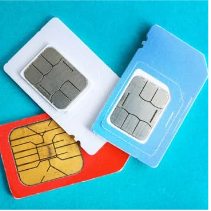Introduction to GSM SIM Cards for GPS Trackers
GPS trackers have become an increasingly popular tool for a variety of applications, from fleet management to personal safety. At the heart of these devices lies the GSM SIM card, which enables the tracker to communicate with cellular networks and transmit location data. Understanding the role of GSM SIM cards in GPS tracking is crucial for ensuring the optimal performance and reliability of these systems.

In this blog post, we will explore GSM SIM cards for GPS trackers. We will cover how they work, the types available, and how to choose a plan for your needs. We’ll also delve into the installation and activation process, troubleshooting common issues, and the future developments in this technology.
How GSM SIM Cards Work in GPS Tracking Devices
GSM (Global System for Mobile Communications) is the most widely used standard for mobile communication networks worldwide. GPS trackers use this technology. They have a GSM SIM card. It lets them connect to the cellular network and send location data.
When a GPS tracker has a GSM SIM card, it can establish a connection with the nearest cellular tower. This connection enables the device to send and receive data, including the GPS coordinates of the tracked object or individual. The SIM card is the device’s unique identifier. It lets the cellular network recognize the device. The device can then talk to the tracking platform or app.
The process of data transmission from a GPS tracker with a GSM SIM card typically involves the following steps:
- The GPS module in the tracker acquires the current location coordinates.
- The GSM module uses the SIM card to connect to the cellular network.
- The location data is then sent over the cellular network. It goes to the tracking platform or application.
- The platform or application processes the data and displays the location on a map or provides other relevant information.
GPS and GSM are seamlessly integrated. This integration lets GPS trackers give real-time locations. This makes them valuable for many uses. For more information on how GPS tracking works, check out our article on the basics of GPS tracking.
Types of GSM SIM Cards Compatible with GPS Trackers
When it comes to GSM SIM cards for GPS trackers, there are several different types to consider. The most common options include:
- Standard SIM Cards: These are the traditional SIM cards used in mobile phones and other devices. They come in various sizes, including full-size, micro-SIM, and nano-SIM.
- Embedded SIM (eSIM): The GPS tracker device has embedded SIMs. They remove the need for a physical SIM card. eSIMs offer remote SIM provisioning. Users can activate and manage their cellular service without swapping the SIM card.
- M2M (Machine-to-Machine) SIM Cards: Designed specifically for machine-to-machine (M2M) communication, these SIM cards are optimized for use in GPS trackers and other IoT (Internet of Things) devices. M2M SIM cards often come with specialized features, such as extended coverage, enhanced security, and remote management capabilities.
- Dual-SIM GPS Trackers: Some GPS trackers can simultaneously accommodate two SIM cards. This can be useful for redundancy, allowing the device to switch between networks or maintain connectivity in areas with limited coverage.
When choosing a GSM SIM card for your GPS tracker, ensure it works with the device and its intended use. To ensure top performance and reliability, consider factors. These factors include network coverage, data plans, and security. To learn more about choosing the right GSM SIM card for your needs, read our guide on selecting the best GSM SIM card for GPS tracking.
Choosing the Right GSM SIM Card Plan for Your Needs
Selecting the appropriate GSM SIM card plan for your GPS tracking needs is crucial for ensuring reliable and cost-effective performance. Here are some key factors to consider when choosing a plan:
- Data Usage: Determine the expected data consumption of your GPS tracker, taking into account factors such as the frequency of location updates, the amount of data transmitted per update, and any additional features that may require data (e.g., live video streaming).
- Coverage Area: Ensure that the cellular network coverage provided by the SIM card plan aligns with the geographical areas where your GPS trackers will be operating. This is particularly important for applications that require continuous connectivity, such as fleet management or personal safety.
- Contract Terms: Consider the contract length, data allowances, and any additional fees or charges associated with the SIM card plan. Opt for a plan that offers flexibility and scalability to accommodate your evolving needs.
- Security and Data Protection: Look for SIM card plans that offer enhanced security features, such as end-to-end encryption, to protect the sensitive location data transmitted by your GPS trackers.
- Pricing and Cost-Effectiveness: Evaluate the overall cost of the SIM card plan, including any activation fees, monthly/annual charges, and potential overage fees. Aim to strike a balance between cost-effectiveness and the features and performance required for your GPS tracking application.
By carefully evaluating these factors, you can select a GSM SIM card plan that provides the optimal balance of coverage, data usage, security, and cost-effectiveness for your GPS tracking needs. For a more in-depth look at choosing the right GSM SIM card plan, check out our article on optimizing your GSM SIM card plan for GPS tracking.
Installing and Activating a GSM SIM Card in a GPS Tracker
Integrating a GSM SIM card into a GPS tracker typically involves a straightforward installation and activation process. Here’s a step-by-step guide:
- Identify the SIM Card Slot: Locate the SIM card slot on your GPS tracker, which is usually accessible through a small opening or compartment on the device.
- Insert the SIM Card: Carefully insert the GSM SIM card into the designated slot, ensuring that the card is oriented correctly (usually with the gold contacts facing down).
- Power on the Device: Turn on the GPS tracker and wait for it to establish a connection with the cellular network.
- Activate the SIM Card: Depending on the SIM card plan and provider, you may need to activate the SIM card through an online portal, by calling customer support, or by sending a text message with a specific activation code.
- Configure the Tracker Settings: Access the GPS tracker’s settings or management platform and configure the cellular network settings, such as the APN (Access Point Name) and any other required parameters.
- Test the Connection: Perform a test to ensure that the GPS tracker is successfully communicating with the cellular network and transmitting location data to the tracking platform or application.
It’s important to follow the manufacturer’s instructions carefully and consult with your GSM SIM card provider if you encounter any issues during the installation and activation process. Proper integration of the SIM card is crucial for ensuring the reliable and consistent performance of your GPS tracking system.
Troubleshooting Common GSM SIM Card Issues
While GSM SIM cards for GPS trackers are generally reliable, there may be instances where users encounter various issues. Here are some common problems and their potential solutions:
- No Network Connection: If the GPS tracker is unable to establish a connection with the cellular network, check the following:
- Ensure that the SIM card is properly inserted and activated.
- Check that the SIM card plan includes coverage for the area where you will use the tracker..
- Check if the cellular network settings (e.g., APN) are correctly configured.
- Intermittent or Weak Signal: If the GPS tracker experiences intermittent or weak cellular signal, consider the following:
- Evaluate the signal strength in the tracker’s location and consider relocating it to an area with better coverage.
- Ensure that the tracker’s antenna is properly positioned and not obstructed.
- Explore the possibility of using a signal booster or repeater to enhance the cellular reception.
- Data Connectivity Issues: If the GPS tracker is unable to transmit data over the cellular network, check the following:
- Verify that the SIM card plan includes sufficient data allowance for your tracking needs.
- Make sure you configure the data settings on the tracker.
- Contact your SIM card provider to troubleshoot any potential network or billing issues.
- Security Concerns: If you have concerns about the security of your GPS tracking data, consider the following:
- Ensure that the SIM card plan offers end-to-end encryption or other security features.
- Implement additional security measures, such as secure VPNs or data encryption, at the application or platform level.
- Stay informed about the latest security best practices and updates from your SIM card provider and GPS tracker manufacturer.
By addressing these common issues, you can optimize the performance and reliability of your GPS tracking system and ensure the secure transmission of location data. For more detailed troubleshooting tips, refer to our comprehensive guide on resolving GSM SIM card issues in GPS trackers.
Conclusion
GSM SIM cards play a crucial role in enabling GPS trackers to communicate with cellular networks and transmit location data. By understanding how these cards work, the different types available, and how to choose the right plan for your needs, you can ensure the optimal performance and reliability of your GPS tracking system.
Remember to carefully consider factors such as data usage, coverage area, contract terms, security, and cost-effectiveness when selecting a GSM SIM card plan. Additionally, follow the manufacturer’s instructions and consult with your provider when installing and activating the SIM card in your GPS tracker.
If you encounter any issues, refer to the troubleshooting tips provided in this article or seek assistance from your GSM SIM card provider or GPS tracker manufacturer. By staying informed and proactive, you can maximize the benefits of GSM SIM cards in your GPS tracking applications.
For more information on GPS tracking and related technologies, visit our GPS tracking resource center.





